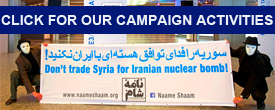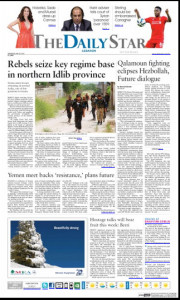 Documenting sectarian cleansing in Syria
Documenting sectarian cleansing in Syria
Fouad Hamdan & Shiar Youssef | The Daily Star | May. 20, 2015 | link
There have been reports and rumors of certain areas of Syria being emptied of their Sunni residents, to be replaced with Shiite and Alawite supporters of the Syrian and Iranian regimes. Yet, more than four years after the start of the Syrian conflict, with millions of displaced and the homes of many destroyed or expropriated, the international community is not acting to stop what appears to be a silent sectarian cleansing taking place.
The Naame Shaam campaign has produced an in-depth report, “Silent Sectarian Cleansing: Iranian Role in Mass Demolitions and Population Transfers in Syria,” focusing on this very issue. The report looks into two specific war crimes and crimes against humanity being committed in certain parts of Syria: the unlawful destruction and appropriation of civilian property, and the forcible displacement and transfer of the civilian population.
Together, these crimes constitute what appears to be a state policy of sectarian cleansing, driven by a combination of mafia-style war profiteering linked to the inner circle of the Syrian regime, as well as a program of Shiitization pushed and financed by the Iranian regime and implemented with the help of the Lebanese Hezbollah.
The report accuses President Bashar Assad’s regime and its backers of changing, or attempting to change, the demographic composition of certain strategic areas in Syria, such as Damascus and Homs, using unlawful means.
Satellite images published by the United Nations show vast urban areas razed to the ground. These demolitions appear to have been intended to “cleanse” those areas of all “unwanted elements,” a majority of whom are Sunni, to prevent them from returning to their homes in the future. The number of people affected could be in the hundreds of thousands.
The destruction is then followed by dubious “reconstruction” projects, some of which have been in the pipeline for a long time. The war was simply used as cover to implement these old plans. For example, the documented demolitions in the Mazzeh area of southern Damascus appear to be a continuation of a plan of creating an “Iranian zone” there, similar to the Hezbollah-controlled southern suburbs of Beirut.
The Syrian and the Iranian regimes have also been buying – either directly or through agents – large areas of property in Homs, Damascus and, to a lesser extent, Aleppo. They have also been “legally stealing” property by falsifying official documents or forcing people to sell their property.
Like most things in Assad’s Syria, these projects are being implemented by mafias linked to the inner circles of the Syrian and Iranian regimes, particularly Rami Makhlouf’s company Cham Holding, Iyad Ghazal’s Cartel Group, the Damascus and Homs City Councils and possibly the Iranian Revolutionary Guard’s construction and engineering arm Khatam al-Anbia.
Various Iranian officials also appear to be implicated in these schemes, which amount to war crimes and crimes against humanity under international law. These include the Iranian ambassador to Syria, the Iranian mediator in Homs known as Hajji Fadi, Iranian businessmen and Iranian Revolutionary Guard commanders. The main person implicated is Gen. Qasem Soleimani, the head of the Quds Force, the foreign operations arm of the Revolutionary Guard.
We argue that the ultimate aim of these sectarian cleansing schemes is to secure the Damascus-Homs-Syrian coast corridor along the Lebanese border in order to provide geographical and demographic continuity between regime-held areas and Lebanon, in that way securing arms shipments to Hezbollah.
Indeed, this is the main reason for Iran’s uncompromising determination to save Assad’s regime. It would maintain a strong deterrent against any possible Israeli or Western attack against Iran’s nuclear facilities. This line of defense is meant to secure the Iranian regime’s survival. If the Assad regime falls, Iran’s arms shipments to Hezbollah are likely to stop and Hezbollah would no longer be the deterrent against Israel that it is now.
The report provides various examples and indicators but notes that more evidence is needed to determine the scale and perpetrators of the above-mentioned war crimes and crimes against humanity. There are, however, enough leads to warrant a systematic investigation by concerned international bodies, such as the International Criminal Court in The Hague. This should include the role of Iranian officials and commanders, particularly Soleimani.
The ICC prosecutor should also accept an offer made public in March 2015 by the U.N. Independent International Commission of Inquiry on the Syrian Arab Republic to share the names and details of the Commission’s list of suspects with any prosecution authorities preparing cases about war crimes and crimes against humanity committed in Syria.
In this context, we call on the United States and its allies to treat the war in Syria as an international armed conflict involving a foreign occupation by Iran and its militias, as well as a liberation struggle by the Syrian people against this occupation.
Last November, Naame Shaam published another report on the Iranian regime’s role in Syria titled: “Iran in Syria: From an Ally of the Regime to an Occupying Force.” It details how Iran’s Revolutionary Guard assumed a leading role in all major military operations attributed to the Syrian regime and how Iranian and Hezbollah commanders are in control of most Syrian regime forces, as well as Iraqi and Afghan Shiite militias.
In addition to legal recommendations to concerned international bodies, Naame Shaam also calls on the U.S. and its allies to impose no-fly zones to protect civilians and allow humanitarian access throughout Syria, in line with the international “responsibility to protect” norm. This can only work, we argue, if it is part of a strategy of arming and training enough moderate Syrian rebels, not only to fight ISIS and Al-Qaeda-linked groups, but also Syrian and Iranian regime forces and militias.
The people of Syria need to know they did not make a mistake in March 2011 when they took to the street demanding freedom and dignity. Millions of refugees need to believe that they will be able to return to their homes and that justice will prevail.
Fouad Hamdan, a Lebanese, is the executive director of the Rule of Law Foundation (www.lawrules.org), which supports the Naame Shaam campaign. Shiar Youssef, a Syrian, is the head of Naame Shaam’s Research and Advocacy team. Naame Shaam, which means “Letter from Syria” in Persian, is a group of secular Iranian, Syrian and Lebanese activists and citizen-journalists focusing on exposing the Iranian regime’s role in Syria. The Naame Shaam reports can be found at: www.naameshaam.org.
This commentary was written for THE DAILY STAR.
 English
English  فارسی
فارسی  العربية
العربية 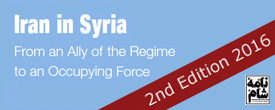
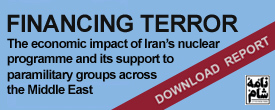
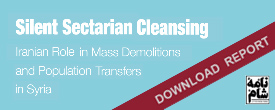
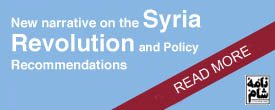

 On Twitter
On Twitter